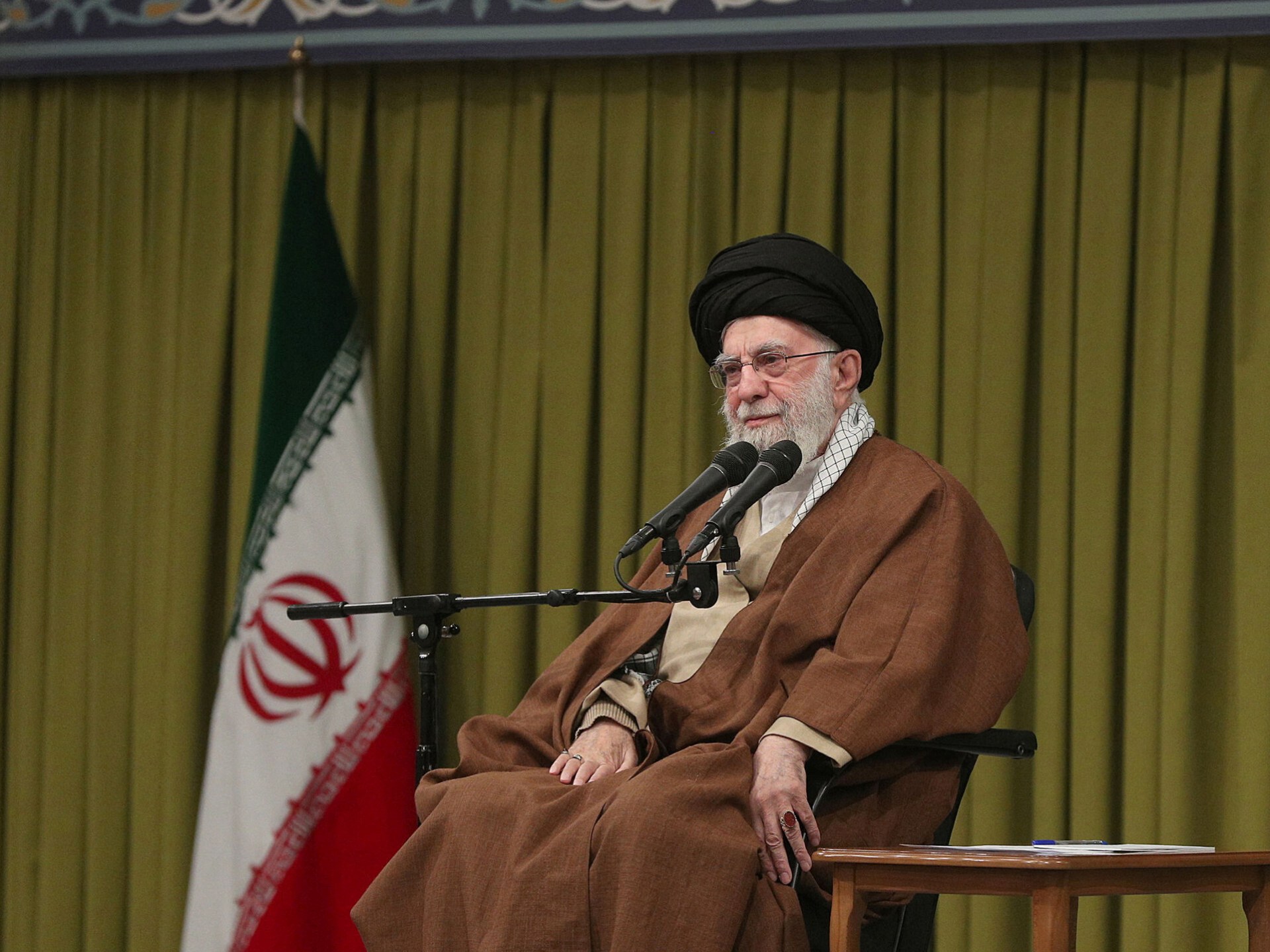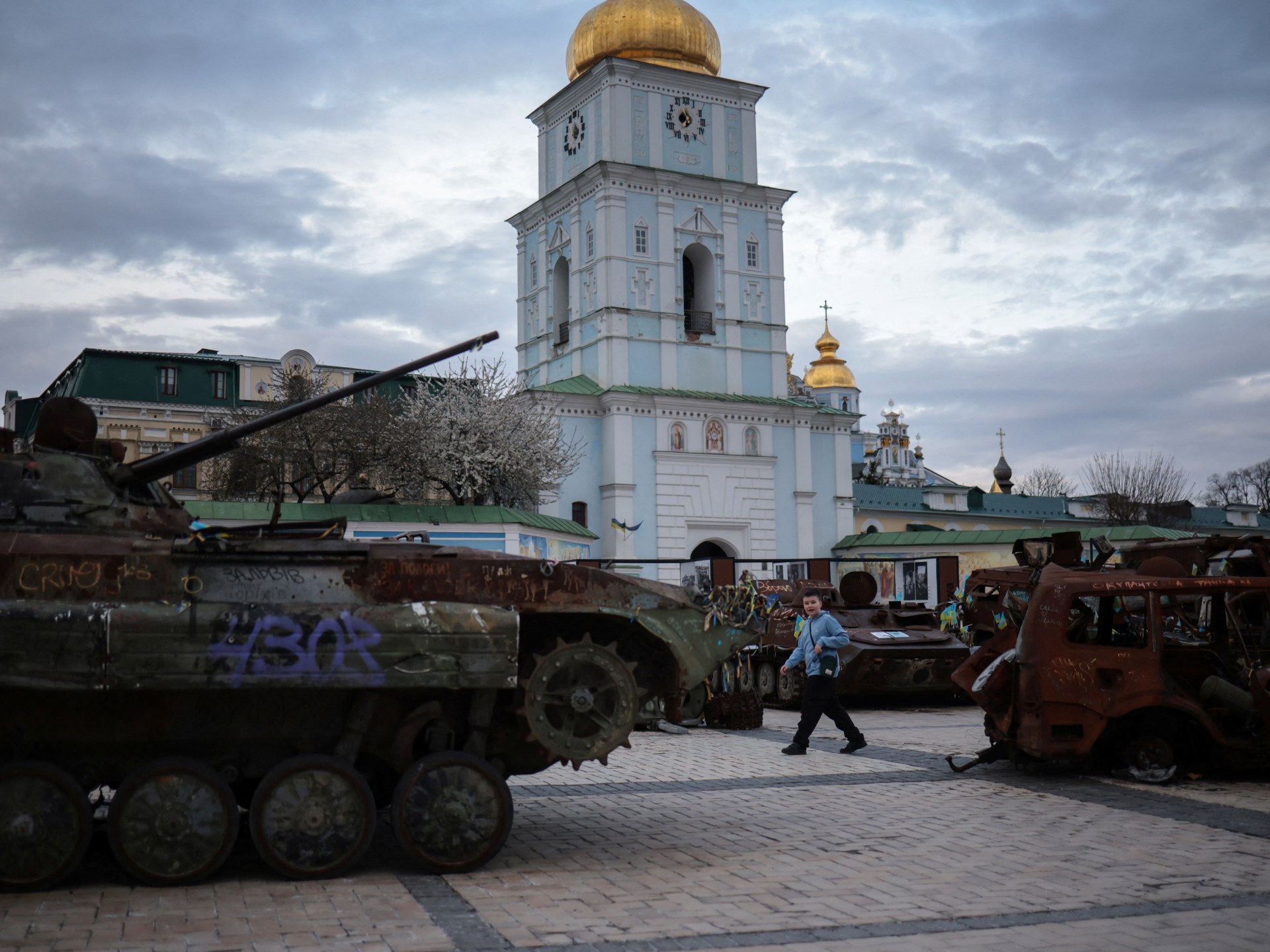Conflict Zones
Iran ‘must stop and eliminate’ nuclear enrichment, says US envoy Witkoff | Nuclear Energy News

Washington, DC – United States special envoy Steve Witkoff has said that Tehran “must stop and eliminate” its nuclear enrichment programme to reach a deal with Washington, seemingly raising the bar of US demands ahead of another round of talks with Iranian officials.
Witkoff’s remarks on Tuesday appear to contradict his suggestion a day earlier that the US would be satisfied with Iran enriching uranium at a low level to produce energy.
“Any final arrangement must set a framework for peace, stability, and prosperity in the Middle East – meaning that Iran must stop and eliminate its nuclear enrichment and weaponization program,” Witkoff said in a statement on Tuesday.
“It is imperative for the world that we create a tough, fair deal that will endure, and that is what President Trump has asked me to do.”
Witkoff’s official title is special envoy to the Middle East, but US President Donald Trump has given him several high-stakes responsibilities beyond the region, including spearheading talks with Russia as well as Iran.
The State Department echoed Witkoff’s latest statement about the Iran negotiations later on Tuesday, explaining that the US seeks to “eliminate” Iran’s uranium enrichment.
Witkoff had been part of a round of negotiations with Iranian officials and was in direct contact with Iran’s Foreign Minister Abbas Araghchi in Oman on Saturday. Further talks are scheduled for April 19.
‘They do not need to enrich past 3.67 percent’
Speaking to Fox News on Monday, Witkoff suggested that the US wants Iran to cap its uranium enrichment, a process of changing the atomic composition of uranium to produce nuclear fuel. When enriched at 90 percent, uranium can be used for weapons.
“They do not need to enrich past 3.67 percent,” Witkoff said. “In some circumstances, they’re at 60 percent. In other circumstances, 20 percent. That cannot be. And you do not need to run — as they claim — a civil nuclear programme where you’re enriching past 3.67 percent, so this is going to be much about verification on the enrichment programme.”
That assertion garnered criticism from conservative hawks who have been calling for abolishing the Iranian enrichment programme altogether.
Tehran and Washington have gone through talks and tensions over the nuclear programme for decades. Successive US administrations have said that preventing Iran from acquiring a nuclear weapon was a top foreign policy priority.
In 2015, the US was a key party in the Joint Comprehensive Plan of Action (JCPOA), a deal that saw Iran scale back its uranium enrichment to 3.67 percent in exchange for the lifting of international sanctions against its economy.
The US administration of then-President Barack Obama, a Democrat, hailed that deal as a means of preventing Iran from acquiring nuclear weapons. But Trump, a Republican, nixed the deal in 2018 during his first term.
Since then, the US has been piling sanctions on Iran, and Tehran has escalated its nuclear programme in response. After returning to the White House for a second term this year, Trump re-launched his so-called maximum pressure campaign against Iran, with the aim of choking off Iranian oil exports, particularly to China.
During his interview with Fox, Witkoff implied that the Trump administration is seeking concessions from Iran beyond the JCPOA, particularly over its missile programme.
He said Washington is seeking “verification on weaponisation” from Iran, including “the type of missiles that they have stockpiled there”.
However, his statement on Tuesday seems to indicate the US would like to see all uranium enrichment in Iran cease.
While Iranian officials have been saying for decades that the country is not seeking a nuclear bomb, they have also stressed that their country has a right to use and create nuclear energy.
Tensions between the two countries have been particularly high over the last month.
In mid-March, Trump threatened to retaliate against Iran should one of its regional allies, the Houthi group in Yemen, continue its attacks on shipping vessels in the Red Sea.
“Every shot fired by the Houthis will be looked upon, from this point forward, as being a shot fired from the weapons and leadership of IRAN, and IRAN will be held responsible, and suffer the consequences, and those consequences will be dire!” Trump wrote on his platform Truth Social.
Trump also indicated US could consider military action if the current round of nuclear talks falls through. “If the talks aren’t successful with Iran, I think Iran is going to be in great danger,” he said last week.
Still, the US president has also stressed that he prefers a diplomatic deal to ensure that Tehran never acquires a nuclear weapon.
That was a position his press secretary, Karoline Leavitt, reiterated on Tuesday, saying Trump “emphasized the need for Iran to end its nuclear programme through negotiations” in a call with Oman’s Sultan Haitham bin Tariq Al Said.
“Of course, the maximum pressure campaign on Iran continues. But as you know, the president has made it clear he wants to see dialogue and discussion with Iran, while making his directive about Iran never being able to obtain a nuclear weapon quite clear,” Leavitt said.
‘Negotiations may or may not yield results’
On Monday, Trump called for speedy negotiations to resolve the issue and again threatened to take “harsh” action against Tehran.
With the talks under way, foreign policy hawks have cautioned Trump against drawn-out negotiations or entering a deal that resembles the JCPOA.
Last week, nine Republican Congress members — including Claudia Tenney of New York and Barry Loudermilk of Georgia — penned a letter to Trump calling for “permanently stripping Tehran of the ability to enrich uranium”.
“The regime in Tehran has mastered the art of delay and deception, using diplomatic negotiations as a shield while advancing its nuclear ambitions,” the lawmakers wrote.
“We cannot afford another failed agreement that enables Iran to play for time. Nor can we repeat the mistakes of the past by permitting Iran to enrich uranium or maintain the capability to ever reconstitute its nuclear program.”
Israel — the US’s top ally in the region — is widely believed to have an undeclared nuclear arsenal.
Iranian officials have also expressed doubt about a new deal, noting that Tehran lived up to its commitments under the JCPOA while the US abandoned the agreement.
“The negotiations may or may not yield results,” Iran’s Ayatollah Ali Khamenei said on Tuesday, according to the Islamic Republic News Agency. “We are neither too optimistic nor too pessimistic about them. Of course, we are very sceptical of the other party, but confident in our own capabilities.”
Conflict Zones
Russia-Ukraine war: List of key events, day 1,150 | Politics News

These are the key events on day 1,150 of Russia’s war on Ukraine.
Here is where things stand on Saturday, April 19:
Fighting
Russia launched eight missiles and 87 drones in an overnight attack on Ukraine on Saturday, causing damage in five regions across the country, the Ukrainian air force said. Air defence units shot down 33 Russian drones while another 36 were redirected by electronic warfare. Damage was recorded in five regions in the south, northeast and east.
A Russian missile attack killed one person in Kharkiv, while a drone attack killed another in Sumy, with at least five children among dozens injured. Kharkiv Mayor Ihor Terekhov said 15 residential buildings, a business and an educational facility were damaged in the attack.
The city of Zaporizhzhia was hit by a Russian drone during the night. Regional Governor Ivan Fedorov reported the attack on Telegram, saying a fire had broken out and emergency services were responding.
Russia claimed it targeted Ukrainian drone production sites and warned of escalation if Germany sends Taurus long-range missiles, calling it a step towards direct involvement in the war.
Politics and diplomacy
The US has put forward a proposal to end the war in Ukraine that includes lifting sanctions on Russia, Bloomberg reported, quoting unnamed European officials. The US plan “would effectively freeze” the conflict, with invaded Ukrainian territory remaining under Russian control, according to the report.
US Secretary of State Marco Rubio briefed NATO chief Mark Rutte on the plan, but warned Washington will “move on” if a ceasefire deal doesn’t appear viable within days.
President Donald Trump later warned that the US would “take a pass” on mediating peace if Moscow or Kyiv continue to hinder progress towards ending the war.
Russia and Ukraine will exchange 246 prisoners each on Saturday in a deal brokered by the UAE. The swap, the 13th mediated by Abu Dhabi, will add to a growing list of exchanges since 2022 and brings the total number of captives swapped to 3,233.
A Russian court has sentenced 19-year-old activist Daria Kozyreva to two years and eight months in prison for allegedly “discrediting” the army through antiwar graffiti and quoting 19th-century Ukrainian poetry. Amnesty International condemned the verdict as a “chilling” attack on peaceful dissent and called for Kozyreva’s immediate release.
Conflict Zones
Could an earthquake shift the balance in Myanmar’s civil war? | Military News
Bangkok, Thailand – As Myanmar slowly recovers from the magnitude 7.7 earthquake that killed thousands in March, an even greater catastrophe continues to shape the nation’s future – this one man-made.
Myanmar remains gripped by a civil war and after four years of fighting the military regime finds itself increasingly encircled.
But the impact of the earthquake could prove decisive for the conflict in the coming year.
Striking in Myanmar’s central Sagaing Region on March 28, the quake killed at least 3,649 people, with more than 5,000 injured and 145 still missing, according to figures from the military government.
The seismic shock flattened houses, factories, Buddhist pagodas, apartment blocks and brought down bridges and ripped up roads in Sagaing city and nearby Mandalay.
It also disrupted electricity supplies to factories producing munitions for the military, said Tin Lin Aung, a former major in Myanmar’s army who defected to the resistance movement in 2022.
In a clear sign that military supplies are stretched, bullet and artillery casings recently captured from government forces bear this year’s manufacturing date, Tin Lin Aung said.
“When I was in the military, we used to joke that some of the bullets were older than us,” he said.
“Now they are being used straight away,” he said.
The reported interruption to the military’s ammunition production comes as areas the army still controls in Myanmar are surrounded on almost all sides by longstanding ethnic armed groups and newer armed opposition forces.
Despite this, the military maintains an iron grip on the country’s major cities and core critical infrastructure.
Hemmed into urban strongholds, the military has tried to reverse its losses through indiscriminate air strikes and burning villages in rural areas – a campaign the United Nations suspects involves war crimes.

‘More momentum than the military’
Sagaing city was devastated by the quake and it remains under military control, while much of the surrounding countryside is governed by a patchwork of resistance militias – such as the People’s Defence Force (PDF) – which are loosely coordinated by the opposition National Unity Government (NUG).
The NUG declared a truce in earthquake-affected areas until April 20, except for “defensive operations”, yet the military’s operations have continued.
According to the NUG, the Myanmar military’s aerial and artillery attacks killed at least 72 civilians between the quake striking on March 28 until April 8. Two more civilians, including a 13-year-old girl, died from bombing by military aircraft on April 10, the Myanmar Now news outlet reports.
A Sagaing-based PDF fighter who requested anonymity said some rebel units had pivoted to relief efforts in central Myanmar even though their military adversaries were taking advantage of the lull in battle.
“Since the quake, the military has used the Sagaing-Monywa road more confidently because of the truce,” she said. But PDF forces in Sagaing expect fighting to intensify after the April truce is over.
“The PDF has more momentum than the military here,” she told Al Jazeera, adding that the NUG is now “coordinating better with ethnic armed organisations”.
“There will be more fighting in coming months,” said Ko Ko Gyi of the Sagaing PDF’s Battalion 3.
Regional security analyst Anthony Davis said he doubted the earthquake would distract the military from its strategic objectives, adding that most soldiers had stayed in their garrisons rather than help with relief efforts.
“The military isn’t taking time off to save people. They’ll keep up the air strikes and, where possible, launch ground offensives to weaken the PDF,” Davis said.
But it is western Rakhine State – largely spared from the earthquake – that is still the most consequential battleground currently, he said.
There, the rebel Arakan Army (AA) has clashed with the military’s forces around the state capital Sittwe and Kyaukphyu, the site of a key pipeline that transports gas from across Myanmar to China.
The AA has simultaneously pushed out of its home territory in the west of the country and into Myanmar’s central heartlands in Magwe, Bago and Ayeyarwady regions, Davis said.
“They are the swing player who can significantly move this conflict one way or another,” he added.
Commanding an estimated 40,000 soldiers, the AA has a proven record of defeating the military regime’s forces.
In eastern Myanmar’s Kayah State, a senior resistance commander said the earthquake had underscored the suffering of displaced communities who “bear the brunt of the ongoing wars”.
“The side who’s willing to care for the people can sway public opinion and will succeed in the coming battles,” he said.
In the north and northwest, the military is on the back foot.
The Kachin Independence Army captured Indaw town in the northern Sagaing Region on April 7 after an eight-month siege, despite declaring its own post-quake truce. Chin resistance forces recently gained control of Falam township in western Myanmar – though they had not announced any ceasefire.
Political analyst Kyaw Hsan Hlaing said the military is still grappling with the aftermath of the earthquake and that may create openings for the AA and others to seize more towns.
“However, any such gains would likely be incremental, as the military’s longstanding control and ability to adapt, especially in regions like Bago and Magwe, even under crisis conditions remain significant,” he said.
“In the long term, the earthquake is unlikely to fundamentally shift the balance of power in Myanmar,” he said.
‘Divine intervention’
While the earthquake has not dealt a decisive blow to military rule, the quake has delivered a psychic shock to the regime’s generals.
In a country where astrology and superstition guide the highest political decisions, many interpret the natural disaster as a cosmic rebuke against Myanmar’s military leadership.
“They see this earthquake as divine intervention – punishment for the mistakes of the king. From what I hear, they are not blaming him [regime leader Min Aung Hlaing] directly. But there are questions about his leadership and capacity,” said former major Tin Lin Aung, who still maintains contacts within the secretive military establishment.
According to Tin Lin Aung, the regime has ordered civil servants nationwide to recite a protective Buddhist chant nine times daily for nine consecutive days. The number nine has auspicious symbolism in Buddhist tradition.
He also described growing confusion within the ranks over the regime’s response to the earthquake – appealing for international aid and assistance, declaring a truce, while also continuing its attacks.
“They know the people hate them more and more, and their leader seems lost,” he said.
Richard Horsey, senior Myanmar adviser at the International Crisis Group, said even if Myanmar military’s commander-in-chief Senior General Min Aung Hlaing dismisses these supernatural interpretations, the fact that his inner circle takes them seriously creates real vulnerability. Instead of causing an internal coup, he suggested the quake as a bad omen would more likely signal the erosion of Min Aung Hlaing’s authority and the rise of open criticism.
“You go from there to people feeling they can just ignore his orders and do their own thing because everyone else agrees with them, not him,” he said.
Political analyst Kyaw Hsan Hlaing said some sources suggest that beliefs in the quake as a portent of collapse for military rule may be used to push the narrative that the regime needs to “act decisively to regain control”.
Superstition is just one of many factors shaping the military’s decisions in the conflict, he added.
The earthquake has also “done enormous damage to the basic fabric of Myanmar,” Horsey said, noting that Mandalay’s residents are potentially facing relocation due to extensive housing damage.
Given the scale of the quake, it would likely affect the civil war – “but in ways that are hard to predict”, he said.

Criticised for its ineffectual and disinterested response to earthquake victims, along with continued attacks at a time of national emergency, the military’s poor reputation has plummeted even further in the eyes of the people and its adversaries.
The powerful ethnic armed groups involved in the conflict will probably be even more unwilling to negotiate for peace with the military following the quake, Horsey said.
“Even if you could get a spirit of compromise, which seems not to exist”, few would believe the military’s sincerity in adhering to any peace deal or ceasefire document.
“Who would believe that piece of paper,” Horsey said, when it is signed by a military that is considered “so illegitimate and so incompetent.”
Conflict Zones
Trump says US may ‘pass’ on helping end war if Russia, Ukraine resist deal | Russia-Ukraine war News

President Donald Trump says the United States will “take a pass” on trying to resolve the Russia-Ukraine war if either Moscow or Kyiv makes it too difficult to end the conflict.
Trump was speaking after US Secretary of State Marco Rubio commented – following talks with European allies in Paris – that Washington would “move on” if a truce did not seem “doable” within days.
The US president refused on Friday to cast blame on either Russian President Vladimir Putin, who ordered the February 2022 full-scale invasion of pro-Western Ukraine, or Ukrainian President Volodymyr Zelenskyy. But he insisted both sides had to make progress.
“Now, if, for some reason, one of the two parties makes it very difficult, we’re just going to say: ‘You’re foolish. You’re fools. You’re horrible people’ – and we’re going to just take a pass,” Trump said.
“But, hopefully, we won’t have to do that.”
Rubio further suggested on Friday that Trump’s patience towards the negotiations is running thin.
“If it’s not possible, if we’re so far apart that this is not going to happen, then I think the president is probably at a point where he’s going to say, ‘Well, we’re done,’” he said.
Trump told reporters on Friday, however, that he did not want to say he was walking away from the talks. He said he still believes there is a good chance to end the conflict.
“It’s coming to a head right now,” he said.
US Vice President JD Vance also said he was “optimistic” a resolution could be reached, while speaking on a trip to Rome.
‘Trying to help’
Ukraine has agreed to a full temporary ceasefire and accused Russia of stalling on a deal to get a better negotiating position.
Putin last month rejected a joint US-Ukrainian proposal for a full and unconditional pause in the conflict, while the Kremlin has made a truce in the Black Sea conditional on the West lifting certain sanctions.
When asked if Putin was stalling, Trump, who held direct talks with the Russian leader in February, said: “I hope not … I’ll let you know soon.”
Trump also denied he was being “played” by the former KGB agent, who denied Russia was going to invade right up until the eve of the attack.
“Nobody’s playing me, I’m trying to help,” Trump said.
Russia’s Foreign Minister Sergey Lavrov said in an interview with the Kommersant newspaper published on Monday that it is “not easy” to agree on “key components” of a peace deal.
He did, however, concede that the Trump administration is trying to understand the “root cause” of the conflict, which he said was triggered by “the actions of Washington and Brussels” in having “brought the current regime to power in Ukraine”.
Fighting continues
Amid ceasefire negotiations, on the front line on Friday, a Russian missile strike killed one person in the northeastern Ukrainian city of Kharkiv, with a separate drone attack killing another person in the nearby city of Sumy.
At least five children were among dozens of people injured in Friday morning’s attack on Kharkiv that damaged 15 residential buildings, a business and an educational facility, according to Kharkiv Mayor Ihor Terekhov and emergency services.
Reporting from Kyiv, Al Jazeera’s Zein Basravi said Russia also targeted Lviv, Dnipro, Mykolaiv and Kyiv.
“We saw multiple missile, drone, artillery and rocket attacks in cities across the country about 5am local time when curfews come to a close and people begin their daily lives,” he said.
“[In Kharkiv], civilian infrastructure was damaged, one person was killed, and 74 were injured. Of the 74, five were children,” Basravi reported.
President Zelenskyy said on Thursday that although Russia had seemingly scaled back its targeting of energy infrastructure, the overall volume of missile and drone attacks remained unchanged. It is striking Ukraine’s civilian sites instead, he added.
Russia has said it had hit “key drone production sites” and Ukrainian military airfields.
Moscow also warned on Friday of potential escalation if Germany proceeds with plans to send Taurus long-range missiles to Ukraine. Speaking at the United Nations on Thursday, Russia’s ambassador, Vassily Nebenzia, declared that such a move would mark Germany’s direct entry into the war.
“These countries are waging a war against Russia using their proxy forces,” he said. “Delivering Taurus missiles would be another step toward escalation.”
-

 Conflict Zones2 days ago
Conflict Zones2 days agoHaiti in ‘free fall’ as violence escalates, rights group warns | Armed Groups News
-

 Sports2 days ago
Sports2 days agoJu Wenjun: Chinese grandmaster makes history by winning fifth Women’s World Chess Championship
-

 Europe2 days ago
Europe2 days agoTrump blasts Fed Chair Powell, saying his ‘termination cannot come fast enough’
-

 Sports2 days ago
Sports2 days agoAaron Boupendza: 28-year-old former MLS player dies after falling from 11th floor balcony in China
-

 Lifestyle2 days ago
Lifestyle2 days agoRalph Lauren stays closer to home this time with intimate Manhattan gallery show
-

 Sports1 day ago
Sports1 day agoLos Angeles Rams honor first responders by conducting 2025 NFL Draft from Los Angeles Fire Department
-

 Education21 hours ago
Education21 hours agoHarvard’s battle with the Trump administration is creating a thorny financial situation
-

 Lifestyle2 days ago
Lifestyle2 days agoLook inside Maine’s ‘Sistine Chapel’ with 70-year-old frescoes




